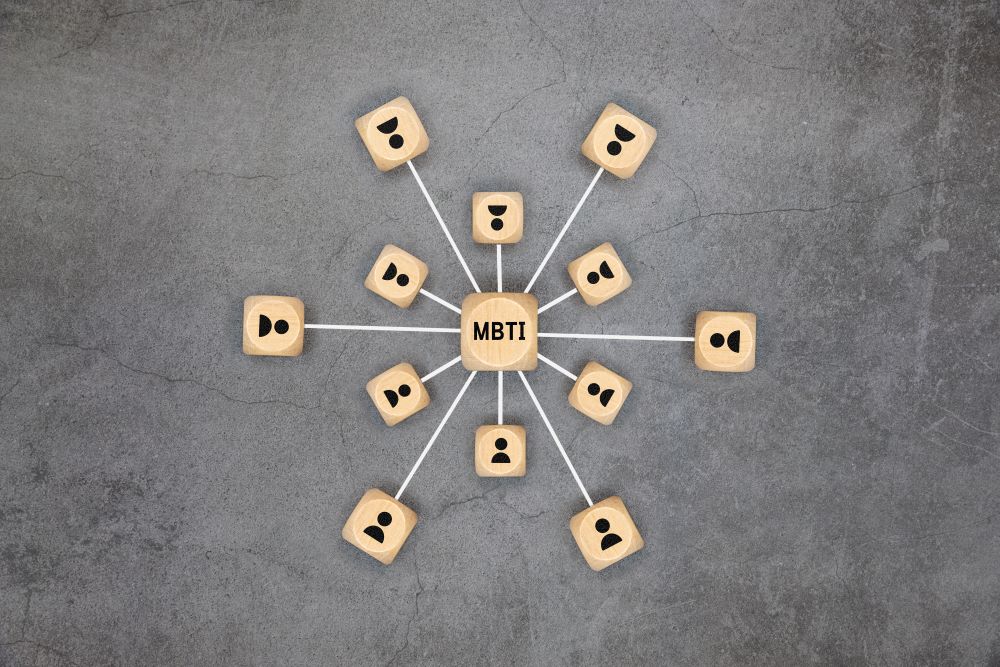MBTI personality types in project management: what does the Myers-Briggs test show?
For a project manager to be effective in managing a project, it is important that his or her personality profile is well suited to the task at hand. In addition, having a clear understanding of the strengths and weaknesses of team members is also a key to success, as it supports optimal task allocation, good communication, risk management and motivating the team to deliver the work on time. In this article, we look at how the Myers-Briggs personality test can help with all of this and what you need to know about the 16 MBTI personality types.

What is Myers-Briggs type theory and what are the MBTI personality types?
The creators of the Myers-Briggs personality test, Katherine Briggs and her daughter Isabel Myers, were fascinated by Carl Gustav Jung's theory of psychological types and realised that they could be successfully applied in real life. It was during World War II that they began to research and develop an index to help understand individual differences. Among other things, it offers an excellent opportunity to understand why someone is more successful than others and what personality traits contribute to the success of a project.

MBTI personality types and their importance
The test classifies people into 16 types based on their answers to the questions. With the Myers-Briggs Type Indicator, respondents can gain a better knowledge and understanding of their own personality, including:
- what they like
- what they find objectionable
- what are their strengths
- what their weaknesses are
- their career preferences
- their compatibility with other people, etc.
The MBTI personality types are not only for self-awareness but also for developing cooperation, which is why they can be important for companies and projects where a leadership development programme is underway.
No MBTI personality type stands out in any way from the rest. There are no right or wrong answers in the test. It is not designed to look for dysfunction or abnormality.
Although the Myers-Briggs test is available in several forms on the online at it is advisable to have it done by a qualified professional.

Scales of the Myers-Briggs test
The questionnaire itself consists of four different scales. Let's look at them now!
Extrovert and introvert
The dichotomy of extroversion and introversion was first explored by Jung in his theory of personality types as a way of describing how people react and interact with the world around them. Although these terms are familiar to most people, their use in MBTI is somewhat different from the traditional understanding.
Accordingly:
- Extroverts, or outgoing people, tend to be action-oriented, enjoy social interactions more often and feel energised after spending time with others.
- Introverts tend to be more thought-focused, enjoy deep and meaningful social interactions, and recharge after being alone.
It's important to remember that we all have some degree of extroversion or introversion, but most of us tend to prefer one or the other.
Sensitive and intuitive
This scale looks at how people gather information from the world around them. As with extroverts and introverts, everyone spends some time using perception and intuition, depending on the situation. According to the MBTI, people tend to be dominant in one area or the other.
- Perceptionists tend to pay a lot of attention to reality, especially to what they perceive through their senses. They focus on facts and details and like to have practical experiences.
- People who prefer intuition are more focused on things like patterns and impressions. They like to think about possibilities, future ideas and abstract theories.
Thinking and feeling
This scale focuses on how people make decisions based on information gathered from their perceptual or intuitive functions.
- Those who prefer thinking put more emphasis on facts and objective data. They tend to be consistent, logical and impersonal when considering a decision.
- Those who prioritise feelings are more likely to take people and emotions into account when reaching a conclusion.
Judging and detecting
The last scale refers to how people relate to the outside world.
- Those who are judgmental types, prefer structure and firm decisions.
- Perceptive people are more open, flexible and adaptable.
These two trends interact with the other scales.
It is also important to know that all people spend some time on extroverted activities. The judging-perceiving scale helps us to describe whether we behave as extroverts when we encounter new information, perceive or intuit. Also, when it comes to making decisions, are we thinkers or feelers.
The meaning of the letters in the Myers-Briggs personality types
The 16 Myers and Briggs personality types have been defined in letters as follows:
- First letter - Where we focus our attention, where we get our energy from: extroverted (E) or introverted (I)
- Second letter - How we learn and receive information: sensory (S) or intuitive (N)
- Third letter - How we make decisions: thinking (T) or feeling (F)
- Fourth letter - How we relate to the world: judging (J) or perceiving (P)
What is the role of MBTI personality types in project management?
Choosing a project manager whose personality profile matches the project he or she is managing can be key to project success.
Within project teams, MBTI personality tests are also an excellent way to assess the type of team members, their strengths and weaknesses. By identifying these, tasks can be assigned more effectively, joint work can be more efficient and productivity can be increased, which ultimately leads to project success.
What can we expect from each MBTI personality type in the project work?
Now let's take a closer look at the 16 personality types and how they behave in the company and project book.
1. ISTJ - The inspector
He is reserved, practical and generally loyal, trustworthy and respectful of tradition.
They are dutiful doers who value clarity, love routine and believe in values such as honesty, hard work and social responsibility.
This personality type is incredibly well organised, which is a huge advantage when working on projects. He or she doesn't need constant direction or supervision - just send them a note at the beginning of the week or discuss the tasks at hand and work can progress at its own pace.
2. ISTP - The creator
They are fiercely independent and enjoy new experiences from which they can learn immediately.
A direct, to-the-point character, loyal to his peers but not overly concerned with laws and rules. The most unpredictable of the 16 personality types, he is typically rational and logical, but can also be enthusiastic and spontaneous.
These people are good at troubleshooting. They work well remotely. They are very good at trying new tools and navigating software, but can easily lose focus. They're the team members most likely to turn off the camera in a meeting and open another window to surf the web, so they require some control.
3. ISFJ - The protector
This type is the most introverted of all the personalities, with a focus on harmony and cooperation. He has a strong work ethic and is sensitive to the wishes and feelings of colleagues.
He is usually a very conscientious worker who is an instinctive manager and can easily bring remote teams together.
It pays great attention to detail, so it's great for checking other people's work, editing shared documents or reviewing proposals.
He's a pro at following the rules and encouraging others to do the same, so entrusting him with time tracking software, for example, could be a good way to increase the efficiency of the whole team.
4. ISFP - The adventurer
Calm and flexible, usually reserved, with an artistic bent.
Warm, approachable, friendly and averse to confrontation. It is important for him to explore new things and experiences.
You like to live in the moment, so you can get completely absorbed in work, which can put you at risk of burnout. It's useful to be reminded, especially if you work remotely, to take a break occasionally and finish the working day on time.
5. INFJ - The advocate
Creative and analytical, it is one of the rarest Myers-Briggs types.
They are usually intuitive, deep thinkers with lots of ideas.
He doesn't like the limelight so much, he does a much more effective job when he can work behind the scenes.
6. INFP - The facilitator
An idealist with good values. Always striving to make the world a better place.
He often gets lost in his imagination and daydreaming. Although he is intensely and enthusiastically involved in projects, it is often a challenge for him to maintain his excitement for long periods of time.
This type tends to get so wrapped up in philosophising about values that it becomes a problem in day-to-day work. There can be latent vulnerabilities, so leaders should encourage team members to voice any concerns openly. Otherwise, the key to getting the best out of them is to reinforce how much they are needed in the team, how valuable the work they do is. If the project is in line with her values, she can be an unstoppable force on the road to success.
7. INTJ - The architect
They are highly logical, very creative and analytical at the same time.
They are perfectionist innovators who are comfortable working alone and perform better when they can, for example, telecommute. These types of people are natural problem solvers who are great at creating an effective plan of action around an idea. They are both intuitive and practical thinkers.
They are extremely deadline-oriented, but also run the risk of making rash decisions, especially if there are no colleagues around to restrain their impulses.
Sometimes they need to be reminded to pause for a moment, take their time and let the seeds of ideas sprout rather than taking hasty steps.
8. INTP - The Thinker
Quiet and introverted individuals who are known for having a rich inner world.
They have excellent expertise and logic. They are comfortable on their own and enjoy seclusion more than any other type.
They may need to be given freedom, to do things in an original way and to be listened to, because they are the ones who come up with the smartest solutions.
Their weakness is that they often neglect to share decisions and results.
9. ESTP - The persuasive
Outgoing and dramatic, they like to spend time with others and focus on the here and now.
Risk takers who trust in the ability to solve big problems quickly. They are passionate about tasks, but can be impatient with longer-term projects because they can only concentrate for short periods. They are entrepreneurial and can be a great asset to any team, but can also be difficult to manage as they have little respect for rules.
This personality type is classically impatient, so it's better to give them a day's worth of tasks to complete during a project, because they can't focus on long-term goals.
Such team members are good at firefighting because the excitement of the moment gives them a buzz. They excel at thinking outside the box, so they shouldn't be constrained or their creativity can be stifled.
10. ESTJ - The Director
They are assertive and rule-oriented, they are principled and have a tendency to take control. Pragmatic decision-makers who are organised, hard-working, methodical and loyal. They are veteran captains.
This group likes to organise itself, other people and the world around it, which can be an advantage, but it can also come across as bossy and aggressive if it gives out instructions without personal contact.
These types of people often need to be reminded to be tactful with others, especially in an environment where communication is mainly by e-mail, as their words can often be misunderstood and can generate conflict.
11. ESFP - The performer
Outgoing and spontaneous types who like to be in the centre of things. They love to show off and show off. They are energetic, enthusiastic and natural performers who often end up in creative or artistic professions.
Entertainers should be given time to shine in front of others. Whenever possible, they should be involved in joint activities. If you need to make videos, podcasts or presentations for any project, they are the perfect subjects. They are very persuasive.
12. ESFJ - The carer
This group is outgoing, kind and considerate and typically puts the needs of others first.
They are the best project managers because people like working for them. They are organised, they have a good overview, they are ideal for getting a project done on time. Their caring, patient nature makes them excellent at helping to integrate new team members.
13. ENFP - The champion
Charismatic and energetic, they like situations where they can show their creativity.
They are intuitive, happy to be with others, and their feelings, as well as their logic, guide their decisions. They are motivated by heartfelt goals rather than money.
This group excels in both idea generation and joint projects, so we can make good use of them in brainstorming sessions.
Their weakness is that they are not the best starters and finishers, so deadlines can be a problem. They need gentle management to work creatively and effectively.
14. ENFJ - The donor
They are loyal and sensitive, understanding and generous. Natural leaders, guided by intuition and feelings rather than logic and rationality.
Inspiring types: highly motivated, but also empathetic to the needs of the people they work with.
They often tend to forget their own needs for the greater good, and this can be harmful. Not only in terms of burnout, but also in the performance of their own tasks.
15. ENTP - The arguer
They are highly resourceful, have lots of ideas and tend to start a lot of projects, but find it difficult to finish them.
Many CEOs fall into this group. This personality type is logical, rational and objective, but needs constant mental stimulation. It is common for leaders and managers to focus on bigger ideas and resist repetitive tasks and routines.
They are very good debating partners and their strengths are often needed in the work. They are extremely productive, bringing new ideas and products to the business.
They are skilled at impressing customers and winning new business. They often dominate meetings, pushing others into the background.
16. ENTJ - The Commander
They are outspoken and confident, great at making plans and organising projects.
Logical designers who like to break down boundaries and find solutions. They value knowledge and have little tolerance for inefficiency. Above all, they are concerned with goal setting, structure and organisation. They are generally charismatic and confident, and can motivate others towards a common goal.
They are always thinking in the big picture, so they don't always see through the finer details when implementing plans. They may make decisions without taking into account the opinions of others.
If you are a project manager and you think it's important to know your team's strengths and weaknesses, to improve communication, task allocation and productivity, and you would like to develop your competences, then take a look at our current training courses for project managers!

 Designabc
Designabc